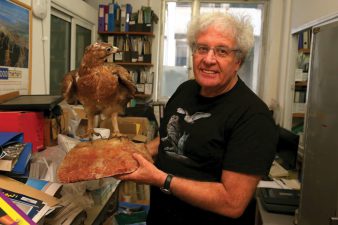
Hughes’ Spruce Goose and the 1933 Soviet Kalilin K7 (above) are some flying ungreen monsters from the past.
Green Prophet was at the last Paris Air Show looking for green innovation in the sky. Now we take a look at some of the old flying monstrosities that got us to where we are today: The world aeronautics industry, after being considered no more than a curiosity venture during WWI and the 1920’s, finally began to get serious about the role that aircraft could play in both civilian and military use during the early to mid 1930’s. During this time, commercial passenger and cargo airline flights began to become reality and the use of these “flying machines” as a viable military weapon also began to take shape.
With oil being cheap and plentiful, there was no problem in supplying fuel for aircraft, and along with this, there was virtually no concern for the effects that aircraft would have on the global environment. Some countries, especially Germany and the Soviet Union began to seriously consider the advantage large aircraft would have as both troop carriers and for use in bombing enemy cities in wartime.
In fact, Nazi Germany was able to effectively test its newly developed military fighters and bombers during the 1936-39 Spanish Civil War, which assisted Germany greatly for its subsequent invasion of Poland in September, 1939, and resulted in the outbreak of WWII.
But it was the Soviets who tried to develop a gigantic type of aircraft that could not only carry large quantities of bombs but large numbers of troops as well. This led to the building of a huge prototype aircraft known as the Kalilin K-7 (pictured above), a monstrous aircraft that had a 173 foot (53 metre) wingspan and which was so heavy that two extra engines had to be added. This is to the already 6 engines that had been originally designed to lift the 24,400 kg behemoth off the ground.
The plane was designed so it could carry either 12,000 kg of cargo (or bombs), or around 120 passengers, who could sit in specially arranged seats inside the wings. In the end, the plane only flew twice, and crashed on its second flight, killing 12 persons on board and one on the ground. Plans for this plane were finally scrapped in 1935.
Howard Hughes’ Flying Ark – The Spruce Goose – Did he use sustainable lumber?

America was also working on large transport aircraft, and this led to the colorful aircraft pioneer and entrepreneur Howard Hughes building a huge transport aircraft prototype during WWII, which he named the H-4 Hercules, and which became known as the “Spruce Goose“. It was made almost entirely out of laminated birch wood due to wartime shortage of aluminum.
Powered by 8 Pratt & Whitney R-4360 radial engines, the five story high “flying ark” only flew once, in 1947, more than two years after the war ended. Hughes had become so obsessed in building this plane that even after it was officially grounded by the US Military, he continued to keep a 300 person maintenance crew on duty to keep the “Goose” in top flying condition until 1962. Although the plane itself didn’t succeed, it is considered to be the forerunner to later mammoth cargo transport planes, including the Lockheed, still in use by the US Air Force; and the Russian Antonov An-124 Ruslan which is still in use today as both a cargo and passenger aircraft.
Both of these aircraft, as well as the new super jumbo A380 Airbus are small in size alongside the monstrous Spruce Goose, now in a museum in Arizona.
Following the grounding of the supersonic Concorde, and a similar Russian model, the Tupolev TU-144, both of which were very polluting and consumed a considerable amount of fuel; and in light of environmental and economic concerns, many airline companies today are looking for ways to cut down on pollution and to make their airlines more “greener”.
Some companies, particular Qatar and Etihad Airways, are making great strives in reducing greenhouse gas on their flights; and many airports, including Israel’s Ben Gurion Airport are trying to reduce airport pollution and noise levels as well.
There’s still a long way to go in making modern passenger, cargo and military aircraft more environmentally friendly; but at least efforts are being made, including the use of less polluting bio-fuels .
The world is a much different place than it was in those aircraft pioneering days of the 1930’s and ’40s, when oil was plentiful and environmental issues were virtually non-existent. Hopefully, the modern aeronautical industry has learned that there’s more involved than just making a profit – there’s ecological responsibility to the planet as well.
Image of Spruce Goose via aviation explorer



It was made out of Sitka Spruce not Birch. Sitka Spruce is a hard light wood that was uses to make airplanes back in this time period because of how strong and light it was.
The Flying Boat is certainly not in a “temporary” facility at the Evergreen Aviation Museum. Check out their web site – it’s a huge (of course) facility, built to house the Flying Boat permanently. Nothing temporary about it. Paul B. Winn
Sorry guys. After rechecking, I see that the “Goose” is now indeed residing in a temporary hangar at the Evergreen Aviation Museum in McMinnville Oregon. Been there since it was brought there, in pieces in 1993, and then lovingly reassembled. The bit about the 300 man crew until 1962 still stands – unless you, Paul, can come up with some bonafide info otherwise.
It is interesting to note the plane was actually the brainchild of Henry J. Kaiser, who was involved in sending Liberty Ships to Europe during WWII. He also was in the auto manufacturing business for a while, and his car, dubbed the Henry J., was as wierd (and unsuccessful) as the Goose was. Kaiser enlisted Hughes’ assistance, which he obliged enthusiastically – even too much, as Hughes literally dedicated himself to this project.
If anyone else has some interesting bits of info to add to this story, please do!
There were NOT 300 in the crew that maintained the Flying Boat in its hangar in Long Beach! There were only 8! Why do you people make up such things? And, as Bob McCaffery says, you don’t even know where it is being exhibited! Doesn’t lend much credence to the rest of your article does it? I was one of Hughes’ personl secretaries, and I knew the entire crew who worked in the hangar at Long Beach. By the way, if you are interested, those same crew members (at least those who were still alive) supervised the moving and re-installation of the Flying Boat in its new location.
The Spruce Goose is NOT in Arizona, It’s in Mcminnville Oregon.